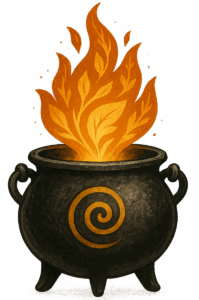Yule is the hinge of the year: the longest night, and the very first turning toward light. The old stories don’t frame darkness as an enemy so much as a necessary season with rich soil for rest, dreaming, and trust. Evergreens came indoors not because we feared the night, but because we remembered that life continues beneath snow. Some folk tales mark this moment with the playful exchange of the Holly and Oak Kings… a mythic shorthand for waning and waxing light.
Historically, hearths were the center of everything at midwinter. Families banked the fire, tended candles through the night, and exchanged practical gifts such as bread, fuel, small promises of mutual care. The Yule log carried embers from old year to new; its ash was thought to bless fields and thresholds. Whatever the details from place to place, hospitality was the core technology: warmth shared against the cold.
In modern druidry I treat Yule as permission granted. Rest is medicine, not failure. A single candle can be a whole vigil. Brew something warm, tell an old story, and let the house be a little quieter than usual. If you have energy, invite a friend who needs company. If you’re tapped out, keep it small and sincere such as a bowl of oranges on the table and a promise to be gentler with yourself will do.
Symbolically, Yule is about enduring life (evergreen), chosen light (candles), and continuity (embers). If you’re in the southern hemisphere, flip the meaning: the “Yule” moment arrives in June, and the invitation to rest and re-center fits just as well. Either way, celebrate the courage to keep a small flame alive until morning.
